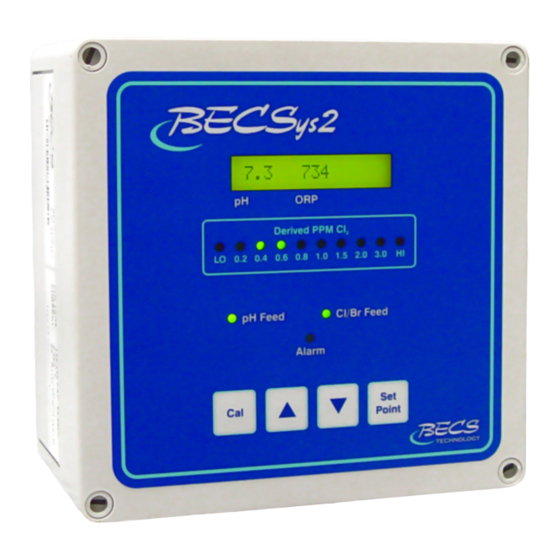BECSys 2 Manual do operador - Página 9
Procurar online ou descarregar pdf Manual do operador para Controlador BECSys 2. BECSys 2 14 páginas.

Operator's Manual
The BECSys2 requires no maintenance other than a
periodic calibration check and sensor cleaning.
C – 1: Potentiometric Sensors (pH and ORP)
C – 1.1: Electrode Cleaning:
Slow response time and large offsets may indicate the
electrode has become coated. The nature of the
coating will dictate the type of cleaning technique
that should be used.
Warning: You may lightly blot the water
On a pH sensor tip on a paper towel, but never
vigorously rub or wipe the pH bulb because this
may scratch the delicate outer layer on the pH
glass impairing its response.
Soft coatings, like bacterial films, are best removed
using a squirt bottle or the water jet from a faucet.
If this is not successful, then gently wipe with a
soft wet cloth.
For a more severe coating, first try a strong
detergent (something similar to Dawn liquid
detergent) and warm water, using a soft brush (like
a toothbrush). Isopropyl alcohol on a Q-tip is
another good choice. Rinse the measuring end in
distilled water before reinstallation.
Greasy and oily coatings are best removed with a
detergent solution or a solvent that will not attack
the sensor body. Methanol and isopropyl alcohol
are good choices for solvents. Acetone, MEK,
THF, or trichloroethane will irreparably harm the
electrode.
Hard coatings, like calcium or lime scale, are best
removed with a solvent appropriate for the
particular coating. A 5% solution of hydrochloric
acid (HCl) would be a good choice for calcium
scale. If unsure of the proper solvent to remove a
hard mineral coating, then alternate between a 5%
hydrochloric acid and a 4% sodium hydroxide
(NaOH) for 10 minutes each. After treating the
electrode with these strong acids or bases, rinse the
electrode with water and soak it in a pH 4 buffer
for at least 1/2 hour.
The platinum tip of an ORP sensor can be cleaned
with an abrasive as a last resort. Gently scour the
platinum with a 600 grit wet emery cloth, or
preferably, a 1-3 micron alumina polishing powder.
9487 Dielman Rock Island Industrial Dr. St. Louis, MO 63132 Tel:(314) 567-0088
Section C: Maintenance
Section C: Maintenance
C – 1.2: Long-Term Storage:
Save the wetting cap that came with the sensor for
long-term storage.
from the flow-cell, clean it as in routine
maintenance, and then store it in the wetting cap
using a pH 4 buffer saturated with potassium
chloride (KCl).
prevent electrolyte from leaching out of the
sensors reference cell. The wetting cap only needs
to be half full. If a number of sites are going to be
serviced, for example, at the end of a season, then
it might be a good idea to carry a pint of 4.0/KCl
storage solution.
Rev: D08
Rev: D08
After removing the sensor
The potassium chloride will
Page 7
